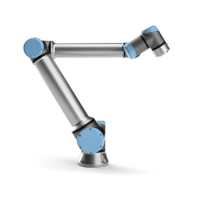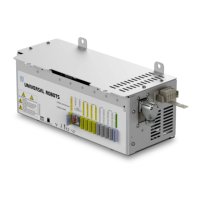•
Teaching the robot during set-up and development of the robot installation
•
Troubleshooting and maintenance
•
Normal operation of the robot installation
A risk assessment must be conducted before the robot arm is powered on for the first
time. A part of the risk assessment conducted by the integrator is to identify the proper
safety configuration settings, as well as the need for additional emergency stop buttons
and/or other protective measures required for the specific robot application.
Identifying the correct safety configuration settings is a particularly important part of
developing collaborative robot applications. See chapter2.Safety-related Functions and
Interfaceson page15 and PolyScope for detailed information.
Some safety functions are purposely designed for collaborative robot applications. These
features are configurable through the safety configuration settings and are particularly
relevant when addressing specific risks in the risk assessment conducted by the
integrator:
•
Force and power limiting: Used to reduce clamping forces and pressures exerted
by the robot in the direction of movement in case of collisions between the robot
and the operator.
•
Momentum limiting: Used to reduce high transient energy and impact forces in
case of collisions between robot and operator by reducing the speed of the robot.
•
Joint, elbow and tool/end effector position limiting: Particularly used to reduce
risks associated with certain body parts. E.g. to avoid movement towards head and
neck.
•
Tool/end effector orientation limiting: Particularly used to reduce risks associated
with certain areas and features of the tool/end effector and work-piece. E.g. to
avoid sharp edges to be pointed towards the operator.
•
Speed limitation: Particularly used to ensure a low speed of the robot arm.
The integrator must prevent unauthorized access to the safety configuration by using
password protection.
A collaborative robot application risk assessment for contacts that are intentional and/or
due to reasonably foreseeable misuse is required and must address:
•
Severity of individual potential collisions
•
Likeliness of occurrence of individual potential collisions
•
Possibility to avoid individual potential collisions
If the robot is installed in a non-collaborative robot application where hazards cannot be
reasonably eliminated or risks cannot be sufficiently reduced by use of the built-in safety-
related functions (e.g.when using a hazardous tool/end effector), then the risk
assessment conducted by the integrator must conclude the need for additional protective
measures (e.g.an enabling device to protect the operator during set-up and
programming).
Hardware Manual 11 UR5e
1.Safety
Copyright © 2009–2022 by UniversalRobotsA/S. All rights reserved.

